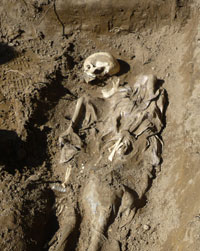CSI Rowan
CSI Rowan

CSI Miami is never like this. Then again, neither is CSI New York, Bones, or any of the other find-the-corpse and solve-it-quick shows that seem to dominate TV today.
On April 10, a bright, peerlessly clear Saturday morning on Rowan's main Glassboro campus, two sets of "remains" were discovered by a team of undergraduate investigators from Maria Rosado's and Jane Hill's forensic anthropology course.
But unlike the sequence of events in a typical TV plot, the recovery was slow. Painfully slow. Not the kind of thing that could be wrapped up in a one-hour time slot with room to spare for commercials.
Following a storyline that included the disappearance a year before of a Rowan faculty member and a friend following a Poconos ski trip, student investigators, responding to reports of a foul odor by the woods outside Rowan Hall, made an arm-to-arm sweep of the area and came upon a flat but suspiciously turned section of ground.
The team of about 10 cordoned off the scene and went to work - first with shovels and other large tools but then, after the first bone was found, with small hand trowels, delicate wooden implements and brushes to excavate without destroying evidence.
Senior chemistry major Allison Lucci, 23, of Pine Hill, the site supervisor and media liaison, explained the situation.
"We know there are human remains," Lucci told a reporter around 1 p.m., several hours after the crime scene was established.
"How do you know?" Professor Rosado prompted.
"We've identified foot bones," Lucci said. "Based on the shape and coloration we know they're human."
Supervising the scene were Rosado, Hill (the co-instructor for the course), Hill's husband (adjunct Professor Richard DeWitt), and Jake, their small gray terrier, who, on this day, played the role of crime dog.
Ever since the course was created several years ago the staged crime investigation has served as a focal point. Lessons in osteology (the study of bones), skeletal anatomy, dentition and archeological techniques lead to the big dig and classes in the closing weeks of the spring semester are used to analyze the copious amounts of data collected at the scene.
Included in this data, in addition to whatever skeletal remains are unearthed, are vast amounts of notes, sketches, maps, charts, photos and video.
Indeed, as two or three students slowly excavate the site and others sift dirt for bone fragments, others photograph and map the site to collect as many layers of inscrutable evidence as possible.
"My job is to map the area and sketch all evidence found," said Jolaine Snyder, 21, a junior biology major from Mount Olive. "That way, if investigators need to, they can look at my maps and sketches and come back to this exact point."
Before arriving on scene, Lucci said, the team was appraised of not just a foul odor but reports of a car found in the woods. That information, coupled with the reports of a missing faculty member and his friend, led the forensics team here.
Loose ends AND bones
Because crime scenes can be chaotic and disordered - bodies not just buried but sometimes dismembered - investigators must not only recover evidence but make sense of it.
"Our job is to gather all the evidence and perform an M.N.I. (minimum number of individuals) test," Lucci said. "With the M.N.I. we log every bone we find. We go through every bone in the body to determine how many bodies there actually are."
Patricia McCabe, a junior geography major, was the site registrar, a position that involved cataloguing evidence or, as they might say on TV, "bagging and tagging."
"It's very, very slow and very methodical," McCabe said. "If you come upon a loose bone it is bagged but the rest you try to keep intact."
Not without fun
Despite the grimness of the task at hand, the starkest truth was that this was an experiment, a field lab, and the students and faculty members had a good bit of fun working the dirt and digging up bones as the afternoon wore on. Jake the crime dog even warmed himself in the sun.
"It's great but I thought we'd be done by now," Snyder said three hours in.
Snyder, who wants to be a pediatric nurse, said the course helped confirm her career goal.
"I definitely learned all the bones in the body," she said. "And I know now I want to actually work with people. I don't want to be in a lab all day."
